
Publisher:
Bonnie King
CONTACT:
Newsroom@Salem-news.com
Advertising:
Adsales@Salem-news.com

~Truth~
~Justice~
~Peace~
TJP
Aug-16-2010 18:43

 TweetFollow @OregonNews
TweetFollow @OregonNews
Front Row of a Drug War
Kent Paterson for Salem-News.comIf current policies and trends continue, the Mexican refugee situation could become an issue for the United Nations.
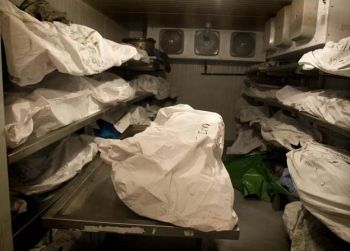 Bodies in a Ciudad, Juarez morgue from a single crime scene tell a good part of the story; the US is not helping in every case; serious discussions about asylum are underway. |
(LAS CRUCES, NM) - They could have been videos from the Middle East or Central Asia. But the images flashed to the crowd at Texas Congressman Silvestre Reyes’ annual border security conference at the University of Texas at El Paso (UTEP) showed graphic scenes from the so-called narco war in the Mexican state of Tamaulipas. After giving a content advisory, the presenter, US Immigration and Customs Enforcement (ICE) official Alonzo Pena, started the show.
In rapid succession, viewers variously saw a pre-decapitation interrogation of one presumed cartel member by rivals, a convoy of 50 vehicles with CDG (Gulf Cartel) insignias calmly passing through a highway toll booth, a squad of gunmen armed with a grenade-launcher and a rocket-launcher carrying out an attack in the town of Camargo, and the body of assassinated 2010 gubernatorial candidate Rodolfo Torre laying on the ground next to his likewise unfortunate companions.
“It’s barbaric and it’s extreme,” summed up Pena, who serves as ICE’s deputy assistant secretary for operations.
Perhaps the most curious picture, however, was the image of a narco-banner displayed in public that contained a detail rarely if ever reported in the Mexican press. Apparently authored by the CDG, the message urged citizens to report sightings of rival Zetas by texting or calling a special hotline. “But don’t send us jokes,” the banner warned.
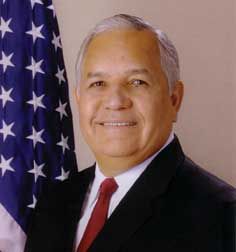 Texas Congressman Silvestre Reyes |
Pena’s slide show depicted events in Tamaulipas across from south Texas, but it could have represented Ciudad Juarez, practically a stone’s throw down the desert bluff and across the neutered Rio Grande from the UTEP conference where hundreds gathered to discuss border security and related issues late last week.
According to the Mexico body count compiled by New Mexico State researcher Molly Molloy, 47 people were murdered in Ciudad Juarez from Friday, August 13 to Sunday, August 15. As of mid-afternoon Monday, August 16, the Ciudad Juarez news websites Lapolaka and El Diario had reported at least eight more victims murdered.
“Everything indicates that by the end of 2010, the city will beat its own macabre record of 2,630 slain in 2009,” Lapolaka predicted.
Held at a critical moment in the history of Ciudad Juarez and Mexico, the UTEP conference was an assessment of Mexican President Felipe Calderon’s anti-organized crime campaign, and generally a ringing endorsement of the anti-drug and security policies jointly pursued by Washington and Mexico City.
Alejandro Hope, director of international affairs for CISEN (Mexico’s CIA), ran down some of the achievements of the offensive unleashed by President Calderon in December 2006. Hope credited the campaign for helping splinter four large drug cartels into smaller ones, adding that the joint military-police operations were successful in Tijuana and Baja California and partially so in 8 other states.
Nationwide, the authorities have seized 84,049 weapons, 6,000 grenades and $411 million in bulk cash, he informed a crowd. To counter the public safety crisis, Mexico’s federal security budget has been roughly doubled from about $5 billion to $10 billion since the end of 2006, the national security official said.
Of more than 28, 000 drug-related murders since December 2006, one-third of the crimes have occurred in four cities-Tijuana, Culiacan, Chihuahua City and Ciudad Juarez, according to Hope. “I think we’re at a crucial point in the struggle against organized crime in Mexico,” Hope declared. “We need to change the tires with the car moving forward.”
Differences over the potential economic power of organized crime in Mexico emerged between Hope and other speakers. In prepared remarks, US Ambassador to Mexico Carlos Pascual cited ICE and DEA estimates of $19 to $29 billion in money-laundered profits in Mexico and the US every year. Dr. Fernando Rodriguez, director of UTEP’s criminal justice program, estimated the annual cross-border drug industry worth $30-$40 billion, with $10 billion of that amount flowing from north to south. Dr. Raul Benitez-Manuat of the National Autonomous University of Mexico’s North American Research Center put the value of cocaine exported to the US from $20 to $30 billion, or about 10 percent of the total worth of US-Mexico trade.
Hope insisted that calculations of the Mexico-based drug trade running in the tens of billions were “plain wrong.” He pegged the amount in the $3-9 billion range, or approximately 8 percent of the yearly value of US-Mexico trade.
In addition, “less than $800 million” was generated from street sales of illegal drugs inside Mexico, Hope told Frontera Norte Sur. Pressed about how much money the cartels earn from other rackets, Hope responded that CISEN does not have such an estimate. “It’s impossible,” he contended.
Truth be told, estimates of the size of the narco-economy are just those-estimates. After all, adding up with precision the income flow of an illegal business is not the same as compiling a market report on corn flakes or hot dogs derived from consumer purchases at the supermarket check-out stand.
In any event, the dough made from dope is enough to outfit private armies, bribe officials, influence elections, invest in other businesses, pay big-name entertainers for private serenades, and support lavish lifestyles.
Despite predictions of greater violence over the spoils of the trade, the general view in El Paso was that US-Mexico security strategy was on the right path.
“It can be done, we can take out these (narco) organizations,” ICE’s Alonzo Pena insisted, pointing to the example of US-Colombian cooperation. “This is a monumental year in Mexican history…it would be great if it could mark 2010 as the beginning of the liberation from the cartels.”
Interesting tribute to the Mexican Revolution with what appears to be, |
The specters of 1810 and 1910, years when Mexico was rocked by violent uprisings against first the Spanish Crown and later the national oligarchy, hang heavy in the air of a country celebrating two historic anniversaries. Certain regions of the country, Ciudad Juarez included, have the smell of civil war.
Benitez-Manuat dismissed the possibility that Mexico is on the verge of civil war. Although a “narco-oligarchy” procreated from the golden semen of the cocaine trade has emerged in recent years, Benitez-Manuat argued, criminal elements still prefer to work behind the scenes and manipulate politicians, policemen and public officials-somewhat like strong-armed corporate lobbyists, if you will.
“They are not idealists, they are not revolutionaries and they aren’t directly attacking the state,” the scholar said in an interview with Frontera NorteSur. “They don’t want the state to collapse.”
Eric Olson, senior associate of the Washington, D.C.-based Wood Wilson International Center for Scholars’ Mexico Institute, concurred with Benitez-Manuat. Still, Olson said, the violence is deeply troubling in its own right.
Olson, who served as Amnesty International’s advocacy director for the Americas from 2002-2006, traveled to Ciudad Juarez as part of a US delegation earlier this year. The group arrived only four days after the Villas de Salvarcar massacre of 15 young people, and even witnessed two of the victims laid up in coffins ready for burial.
Last week, Olson returned to the Villas de Salvarcar neighborhood and spoke with the devastated father of a 17-year-old victim who was a straight-A student on his way to college. The longtime human rights advocate also conferred with US Consulate staff. Olson’s latest visit gave him a sense that ingrained violence will be very difficult to eradicate in the short run.
“You think, gosh, how bad could it get?” Olson mulled. “The scary part is, and I don’t want to be an alarmist by any stretch, is that there are people who believe it’s not gotten to its low point…I hope that’s not true. I think it’s really important that we try to prevent that from happening.”
In a departure from the dominant conference discourse that stressed the cooperation between the Obama and Calderon administrations on the security and trade fronts, Dr. Kathy Staudt of UTEP challenged US corporate and government economic, human rights and drug prohibition policies.
The political science professor was especially perturbed by the big picture presentation of State Department US-Mexico Border Affairs Coordinator Stewart Tuttle that did not consider the deaths of 4,600 migrants attempting to cross the border between 1993 and 2008. During the last two years, hundreds more have died making the dangerous crossing.
In response to a written question from Staudt, Tuttle responded that Washington would welcome ideas to “address at every level.” Staudt, who also has worked as an expert on three asylum cases involving Mexican nationals, questioned US political asylum policy. Fewer than two percent of Mexican claims are approved by US officials- less than many other countries wracked by violence, she said.
In an interview with Frontera NorteSur, Staudt referred to the case of a young woman from Ciudad Juarez who was initially denied asylum, even though her father was murdered by a police commander, her uncle similarly slain, her mother gang-raped, and the surviving family members threatened.
“Something is drastically wrong and outdated with US asylum policy that doesn’t take into account the inability of Mexican law enforcement agencies and institutions to protect its citizens and make sure they are secure.”
As Staudt and others grappled with the issues of the day in El Paso, a news report broke that 100 people had fled a town in Durango because of narco-violence. Staudt, who’s authored numerous books on border violence and economics, noted a similar exodus in the Juarez Valley several months ago when people fled under threat-many of them to little Fort Hancock across the border in Texas.
If current policies and trends continue, Staudt contended, the Mexican refugee situation could become an issue for the United Nations.
“Usually, the US acts as if it’s one of the leaders in human rights and human security, but I think the case of asylum we can see that the US is pursuing policies that are not respectful of human rights and of the tragic insecurity many people are coming in from Mexico,” she added.
Meanwhile, an almost surreal peace prevails in neighboring El Paso, rated by Congressional Quarterly as the second safest city in the US.
On the US side, much of the excitement consists of events such as foam parties in the hip nightclub district only blocks from the border or the “Thirsty Thursday” cut-rate booze specials that draw throngs of youth to establishments across the city. City residents can sometimes see events unfolding in their sister city, just as in the days of the 1910 Revolution when El Pasoans gathered in rooftop parties to watch pitched battles in Ciudad Juarez.
For instance, on Saturday, August 14, commotion on Ciudad Juarez’s Anapra Road running alongside the Rio Grande was visible from El Paso’s Paisano Drive. Two Federal Police trucks with lights flashing maneuvered past abnormally idled vehicles and sped off in the direction of the Bella Vista and downtown neighborhoods, districts where army and police patrols are thick and heavy and frequent shootings now the norm.
______________________________
Frontera NorteSur (FNS): on-line, U.S.-Mexico border news Center for Latin American and Border Studies New Mexico State University Las Cruces, New Mexico
Articles for August 15, 2010 | Articles for August 16, 2010 | Articles for August 17, 2010


Quick Links
DINING
Willamette UniversityGoudy Commons Cafe
Dine on the Queen
Willamette Queen Sternwheeler
MUST SEE SALEM
Oregon Capitol ToursCapitol History Gateway
Willamette River Ride
Willamette Queen Sternwheeler
Historic Home Tours:
Deepwood Museum
The Bush House
Gaiety Hollow Garden
AUCTIONS - APPRAISALS
Auction Masters & AppraisalsCONSTRUCTION SERVICES
Roofing and ContractingSheridan, Ore.
ONLINE SHOPPING
Special Occasion DressesAdvertise with Salem-News
Contact:AdSales@Salem-News.com

Salem-News.com:

Terms of Service | Privacy Policy
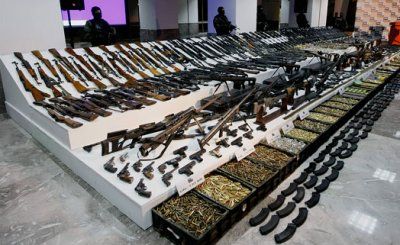
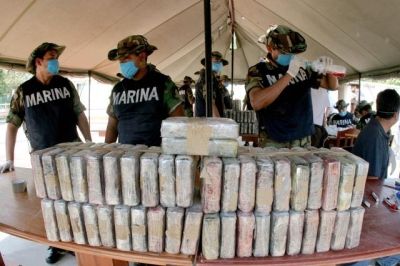
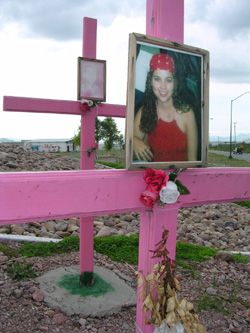

All comments and messages are approved by people and self promotional links or unacceptable comments are denied.
Vic August 17, 2010 7:50 am (Pacific time)
Anyone who thinks that the Mexican govt is not trying to get a handle on this, has not been down here. There are military checkpoints on all main roads and here in San Blas, the Mexican Marines patrol the coastline every day. Going North out of Sinaloa state, EVERY vehicle is stopped and searched...trucks, busses and private vehicles. Once we counted seven miles of vehicles waiting to get through the checkpoint there. Still, even in this out-of-the-way town, there is cartel activity. Anyone who grows or sells marijuanna outside of the cartels is taking a risk. A friend of ours who supplemented his avocado growing business by growing weed in the jungle had armed men break into his house and hold a gun on his 8 year old daughter with the threat that if he didnt stop, they would be back and things would be bad...needless to say, he stopped immediately. I should add that I do not know the name of the cartel involved, nor do I want to know....
Citizen August 16, 2010 10:15 pm (Pacific time)
Ask your self, Why are these cartels fighting so hard to control the area in juarez and El Paso???? Well I would say that the majority of the drugs are getting through El Paso. So....how easy is it to get them through? Or better yet WHY ?
[Return to Top]©2025 Salem-News.com. All opinions expressed in this article are those of the author and do not necessarily reflect those of Salem-News.com.